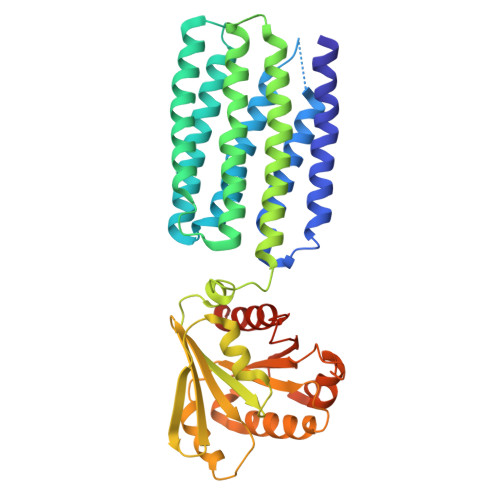Proteorhodopsin insights into the molecular mechanism of vectorial proton transport.
Bukhdruker, S., Gushchin, I., Shevchenko, V., Kovalev, K., Polovinkin, V., Tsybrov, F., Astashkin, R., Alekseev, A., Mikhaylov, A., Bukhalovich, S., Bratanov, D., Ryzhykau, Y., Kuklina, D., Caramello, N., Rokitskaya, T., Antonenko, Y., Rulev, M., Stoev, C., Zabelskii, D., Round, E., Rogachev, A., Borshchevskiy, V., Ghai, R., Bourenkov, G., Zeghouf, M., Cherfils, J., Engelhard, M., Chizhov, I., Rodriguez-Valera, F., Bamberg, E., Gordeliy, V.(2025) Sci Adv 11: eadu5303-eadu5303
- PubMed: 40238873
- DOI: https://doi.org/10.1126/sciadv.adu5303
- Primary Citation of Related Structures:
7AVN, 7AVP, 8RSO, 8RSP, 8RSQ, 8RSR, 8RSS, 9G15, 9G16 - PubMed Abstract:
Bacterial proton pumps, proteorhodopsins (PRs), are a major group of light-driven membrane proteins found in marine bacteria. They are functionally and structurally distinct from archaeal and eukaryotic proton pumps. To elucidate the proton transfer mechanism by PRs and understand the differences to nonbacterial pumps on a molecular level, high-resolution structures of PRs' functional states are needed. In this work, we have determined atomic-resolution structures of MAR, a PR from marine actinobacteria, in various functional states, notably the challenging late O intermediate state. These data and information from recent atomic-resolution structures on an archaeal outward proton pump bacteriorhodopsin and bacterial inward proton pump xenorhodopsin allow for deducing key universal elements for light-driven proton pumping. First, long hydrogen-bonded chains characterize proton pathways. Second, short hydrogen bonds allow proton storage and inhibit their backflow. Last, the retinal Schiff base is the active proton donor and acceptor to and from hydrogen-bonded chains.
- Research Center for Molecular Mechanisms of Aging and Age-Related Diseases, Moscow Institute of Physics and Technology, 141700 Dolgoprudny, Russia.
Organizational Affiliation:




















